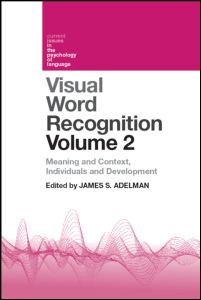Pickering, J., Adelman, J. S., & Inglis, M. (2023). Are Approximate Number System Representations Numerical? Journal of Numerical Cognition, 9(1), 129–144. [PDF]
Adelman, J. S., & Trifonova, I. V. (2022). Orthographic priming from unrelated primes: Heterogeneous feedforward inhibition predicted by associative learning. Journal of Memory and Language, 127, 104372. [PDF]
Trifonova, I. V., & Adelman, J. S. (2022). Repeated letters increase the ambiguity of strings: Evidence from identifcation, priming and same-different tasks. Cognitive Psychology, 132, 101445. [PDF Data etc.]
Trifonova, I. V., & Adelman, J. S. (2019). A delay in processing for repeated letters: Evidence from megastudies. Cognition, 189, 227–241. [PDF]
Adelman, J. S., Estes, Z. & Cossu, M. (2018). Emotional sound symbolism: Languages rapidly signal valence via phonemes. Cognition, 175, 122–130. [PDF]
Trifonova, I. V., & Adelman, J. S. (2018). The sandwich priming paradigm does not reduce lexical competitor effects. Journal of Experimental Psychology: Learning, Memory, and Cognition, 44, 1743–1764. [PDF Data etc.]
Guest, D., Kent, C., & Adelman, J. S. (2018). The relative importance of perceptual and memory sampling processes in determining the time course of absolute identification. Journal of Experimental Psychology: Learning, Memory, and Cognition, 44, 615–630. [PDF]
Nash, R. A., Wade, K. A., Garry, M., & Adelman, J. S. (2017). A robust preference for cheap-and-easy strategies over reliable strategies when verifying personal memories. Memory, 25, 890–899. [PDF]
Guest, D., Adelman, J. S., & Kent, C. (2016). Relative judgement is relatively difficult: Evidence against the role of relative judgement in absolute identification. Psychonomic Bulletin & Review, 23, 922–931. [PDF]
Wonnacott, E., Joseph, H., Adelman, J. S., & Nation, K. (2016). Is children's reading "good enough"? Links between online processing and comprehension as children read syntactically ambiguous sentences. Quarterly Journal of Experimental Psychology, 69, 855–879. [PDF]
Hills, T. T., & Adelman, J. S. (2015). Recent evolution of learnability in American English from 1800–2000. Cognition, 143, 87–92. [PDF]
Estes, Z., Verges, M., & Adelman, J. S. (2015). Words, objects, and locations: Perceptual matching explains spatial interference and facilitation. Journal of Memory and Language, 84, 167–189. [PDF]
Adelman, J. S., & Estes, Z. (2015). Why to treat subjects as fixed effects. Journal of Experimental Psychology: Learning, Memory, and Cognition, 41, 1602–1605. [PDF]
Adelman, J. S., Johnson, R. L., McCormick, S. F., McKague, M., Kinoshita, S., Bowers, J. S., Perry, J. R., Lupker, S. J., Forster, K. I., Cortese, M. J., Scaltritti, M., Aschenbrenner, A. J., Coane, J. H., White, L., Yap, M. J., Davis, C., Kim, J., & Davis, C. J. (2014). A behavioral database for masked form priming. Behavior Research Methods, 46, 1052–1067. [MS PDF Data etc.]
Adelman, J. S., Sabatos-DeVito, M. G., Marquis, S. J., & Estes, Z. (2014). Individual differences in reading aloud: A mega-study, item effects, and some models. Cognitive Psychology, 68, 113–160. [MS PDF Data]
Adelman, J. S., & Estes, Z. (2013). Emotion and memory: A recognition advantage for positive and negative words independent of arousal. Cognition, 129, 530–535. [MS PDF]
Adelman, J. S., Marquis, S. J., Sabatos-DeVito, M. G., & Estes, Z. (2013). The unexplained nature of reading. Journal of Experimental Psychology: Learning, Memory, and Cognition, 39, 1037–1053. [MS PDF Data]
Adelman, J. S. (2011). Letters in Time and Retinotopic Space. Psychological Review, 118, 570–582. [MS PDF Modeling & Data]
Adelman, J. S., Marquis, S. J., & Sabatos-DeVito, M. G. (2010). Letters in words are read simultaneously, not in left-to-right sequence. Psychological Science, 21, 1799–1801. [MS PDF]
Guest, D., Kent, C., & Adelman, J. S. (2010). Why additional presentations help identify a stimulus. Journal of Experimental Psychology: Human Perception and Performance, 36, 1609–1630. [MS PDF]
Adelman, J. S., & Brown, G. D. A. (2008a). Methods of testing and diagnosing model error: Dual and single route cascaded models of reading aloud. Journal of Memory and Language, 59, 524–544. [MS PDF]
Estes, Z., & Adelman, J. S. (2008b). Automatic vigilance for negative words is categorical and general. Emotion, 8, 453–457. [MS PDF]
Adelman, J. S., & Brown, G. D. A. (2008b). Modeling lexical decision: The form of frequency and diversity effects. Psychological Review, 115, 214–227. [MS PDF Example analysis]
Adelman, J. S., & Brown, G. D. A. (2008c). Postscript: Deviations from the predictions of serial search. Psychological Review, 115, 228–229. [MS PDF attached with above]
Estes, Z., & Adelman, J. S. (2008a). Automatic vigilance for negative words in lexical decision and naming: Comment on Larsen, Mercer, and Balota (2006). Emotion, 8, 441–444. [MS PDF]
Adelman, J. S., & Brown, G. D. A. (2007). Phonographic neighbors, not orthographic neighbors, determine word naming latencies. Psychonomic Bulletin & Review, 14, 455–459. [MS PDF]
Adelman, J. S., Brown, G. D. A., & Quesada, J. F. (2006). Contextual diversity, not word frequency, determines word naming and lexical decision times. Psychological Science, 17, 814–823. [MS PDF Correlation Matrices]

 easyNet is our project to develop a software tool for computational modelling, addressing several obstacles facing both expert and novice modellers in gaining the maximum benefit out of modelling. This project was currently supported by a Leverhulme Trust Project Grant.
easyNet is our project to develop a software tool for computational modelling, addressing several obstacles facing both expert and novice modellers in gaining the maximum benefit out of modelling. This project was currently supported by a Leverhulme Trust Project Grant.  Word frequency — the simple count of how often a word has occurred — has been the most ubiquitous lexical variable for some time. We have shown that its effects on reading times can be explained (better) by contextual diversity — the number of distinct documents in which a word has occurred — which is consistent with spacing effects in memory and learning (Adelman et al., 2006). We have also examined the nonlinear relationship between this contextual diversity and lexical decision in terms of different mathematical models (Adelman & Brown, 2008). This project was supported by the ESRC.
Word frequency — the simple count of how often a word has occurred — has been the most ubiquitous lexical variable for some time. We have shown that its effects on reading times can be explained (better) by contextual diversity — the number of distinct documents in which a word has occurred — which is consistent with spacing effects in memory and learning (Adelman et al., 2006). We have also examined the nonlinear relationship between this contextual diversity and lexical decision in terms of different mathematical models (Adelman & Brown, 2008). This project was supported by the ESRC. 


